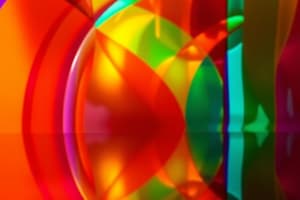Podcast
Questions and Answers
What type of image does a convex mirror produce?
What type of image does a convex mirror produce?
- Real and smaller
- Virtual and larger
- Virtual and smaller (correct)
- Real and larger
Which law describes the relationship between the angle of incidence and the angle of reflection?
Which law describes the relationship between the angle of incidence and the angle of reflection?
- The angle of incidence is always greater than the angle of reflection.
- The angle of reflection is half the angle of incidence.
- The angle of incidence is double the angle of reflection.
- The angle of incidence equals the angle of reflection. (correct)
What does the term 'refractive index' refer to?
What does the term 'refractive index' refer to?
- The amount of light reflected by a surface.
- The ratio of the speed of light in vacuum to the speed of light in a medium. (correct)
- The bending angle of light when it passes through a lens.
- The speed of light in air compared to vacuum.
What is the primary use of concave mirrors?
What is the primary use of concave mirrors?
Which type of lens is classified as a diverging lens?
Which type of lens is classified as a diverging lens?
Flashcards
Refraction
Refraction
A change in direction of light when it passes from one medium to another
What happens to light when it enters a denser medium?
What happens to light when it enters a denser medium?
The bending of light rays towards the normal when light travelsfrom a rarer medium to a denser medium
Concave Mirror
Concave Mirror
A mirror with a curved reflecting surface that curves inwards
Convex Lens
Convex Lens
Signup and view all the flashcards
Power of a Lens
Power of a Lens
Signup and view all the flashcards
Study Notes
Light and Its Properties
- Light travels in straight lines.
- Light reflects and refracts when interacting with surfaces.
Reflection of Light
- Laws of Reflection:
- Angle of incidence equals angle of reflection.
- Incident ray, reflected ray, and normal are in the same plane.
- Types of Mirrors:
- Plane Mirror: Creates a virtual, upright, and same-sized image.
- Spherical Mirrors:
- Concave Mirror: Can form real or virtual images.
- Convex Mirror: Forms a virtual, smaller image.
- Mirror Formula: 1/f = 1/v + 1/u
- f = focal length
- u = object distance
- v = image distance
- Magnification (m): m = -v/u or m = h'/h
Refraction of Light
- Refraction: Bending of light when passing from one medium to another.
- Laws of Refraction:
- Incident ray, refracted ray, and normal are in the same plane.
- Sine of angle of incidence /sine of angle of refraction = constant (Snell's Law)
- Refractive Index (n): n = speed of light in vacuum / speed of light in medium
Lenses
- Types of Lenses:
- Convex Lens (Converging): Can form real or virtual images.
- Concave Lens (Diverging): Forms only virtual images.
- Lens Formula: 1/f = 1/v - 1/u
- f = focal length
- v = image distance
- u = object distance
- Magnification (m): m = h'/h
- h' = height of image
- h = height of object
Power of a Lens
- Power (P): Ability of a lens to bend light, measured in diopters (D).
- P = 1/f (in meters)
Applications
- Concave Mirrors: Telescopes, shaving mirrors, headlights.
- Convex Mirrors: Rearview mirrors.
- Lenses: Spectacles, cameras, microscopes.
Studying That Suits You
Use AI to generate personalized quizzes and flashcards to suit your learning preferences.




